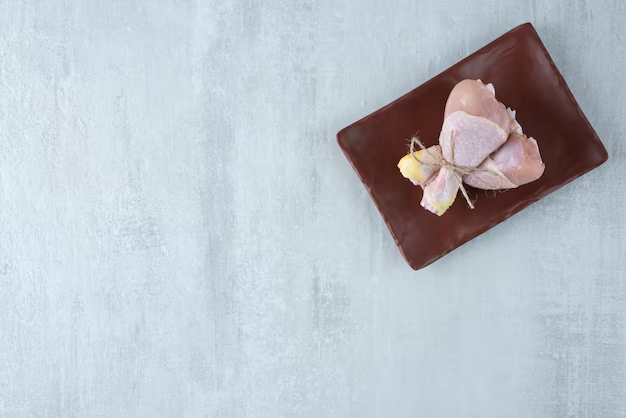How Long Can Raw Chicken Stay Fresh in Your Refrigerator?
In today's fast-paced world, the refrigerator has become an indispensable part of our kitchen. Yet, a common question lingers in the kitchens of many homes: "How long can raw chicken sit in the refrigerator?" This is not just a matter of taste or texture but a crucial concern for food safety. Improper handling of raw chicken can lead to foodborne illnesses, so understanding the shelf life and optimal storage conditions is vital for every home cook. Let's dive into this important topic to ensure you're storing your chicken safely and efficiently.
🕰️ The Lifespan of Raw Chicken in the Fridge
Ideal Storage Time
Raw chicken can generally be stored in the refrigerator for 1 to 2 days. This time frame ensures the meat remains fresh and safe to consume. After this period, the quality begins to degrade, and there's an increased risk of bacteria growth, which can potentially cause foodborne illnesses.
Understanding Freshness Preservation
The fridge is an excellent tool for slowing down the growth of bacteria, which thrives at room temperature. However, certain bacteria can still grow at lower temperatures, albeit at a slower rate. Therefore, it's crucial to not only rely on refrigeration but also to consume meats like chicken within their recommended timeframe.
🐔 Best Practices for Storing Raw Chicken
Proper Packaging
To maintain freshness, it’s essential to store chicken in airtight packaging. Here are some tips:
- Use plastic wrap or aluminum foil to cover the chicken if its original packaging is damaged.
- Place chicken in a sealable plastic bag to prevent any leakage or cross-contamination with other foods in the fridge.
- Investing in vacuum-seal bags can also enhance preservation and minimize exposure to air.
Optimal Refrigerator Conditions
To ensure food safety, your refrigerator should ideally be set to a temperature below 40°F (4°C). This slows down bacterial growth significantly. Consistently check your fridge's temperature and maintain a clean environment to prevent contamination.
Positioning in the Refrigerator
Store raw chicken on the bottom shelf, ideally in a dedicated drawer or zone meant for meats. This prevents any drips from contaminating other foods below, reducing the risk of cross-contamination.
📝 Recognizing Spoiled Chicken
Even with careful handling, it's crucial to be able to identify signs of spoilage in raw chicken:
- Odor: A strong, unpleasant smell is a clear indicator of spoilage.
- Texture: Slimy or sticky surfaces suggest bacterial growth.
- Color Change: If the chicken turns gray or has green spots, it's time to discard it.
When in doubt, it's always safer to discard questionable meat than risk potential health issues.
❄️ Freezing for Extended Shelf Life
For those who don't plan to use raw chicken within the 2-day window, freezing is an effective method to extend its shelf life. Here's how:
Proper Freezing Techniques
- Thoroughly Wrap: Use heavy-duty freezer bags or airtight containers to prevent freezer burn.
- Label the Package: Include the date of freezing to track its shelf life.
- Use a Freezer Safe Vacuum Sealer: This can help extend the life even further by removing air.
How Long Does Frozen Chicken Last?
When properly sealed, raw chicken can be frozen for up to 9 months. Beyond this, while the chicken may still be safe to eat, quality and flavor can begin to degrade.
🌡️ Thawing Safety
When it comes time to use your frozen chicken, thawing it safely is just as important as how you freeze or store it. Here are three methods to do it right:
In the Refrigerator
Best Method: Move chicken from freezer to fridge a day before preparation. This maintains a safe temperature as it thaws and keeps tissue damage minimal.
Cold Water Thawing
If you need quicker defrosting:
- Submerge chicken in cold water.
- Change the water every 30 minutes to ensure it stays cold.
Microwave Thawing
For those in a hurry, microwave thawing is an option. However, this method can partially cook the chicken's outer layers, so plan to cook it immediately after thawing.
🙅 Common Mistakes to Avoid
Missteps in handling raw chicken can lead to larger issues, so avoid these common mistakes:
- Letting Chicken Sit Out: Never thaw or leave raw chicken at room temperature.
- Refrigerator Overcrowding: Ensure proper air circulation inside your fridge.
- Ignoring Expiration Dates: Pay attention to sell-by and use-by dates for the freshest taste and safety.
📝 Helpful Tips for Managing Chicken Storage
Here's a quick summary to keep your kitchen safe and your chicken fresh:
- 🗓️ Plan Meals: Use fresh chicken within 1-2 days or freeze it.
- 🔍 Inspect Before Use: Check for unusual smells or textures.
- 💡 Use Indicators: Consider fridge thermometers or smart indicators to ensure optimal temperature.
🍽️ Enjoying Your Chicken Safely
Appreciating the taste and versatility of chicken starts with proper storage and handling. By being mindful of how long raw chicken can sit in the refrigerator and how it's stored, you can keep your meals both delicious and safe. Regularly update your knowledge on food safety practices and adapt your methods as needed to maintain a safe cooking environment.
Understanding these insights not only boosts your kitchen confidence but contributes significantly to your overall well-being. After all, ensuring food safety is every home cook's responsibility. Now that you're equipped with the knowledge of chicken storage, you can navigate your kitchen with authority and peace of mind. Happy cooking! 🍳
